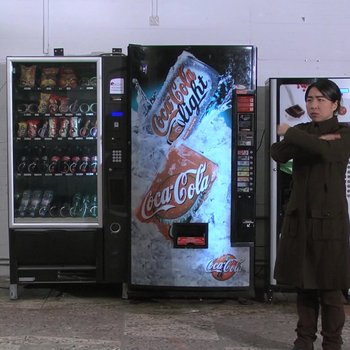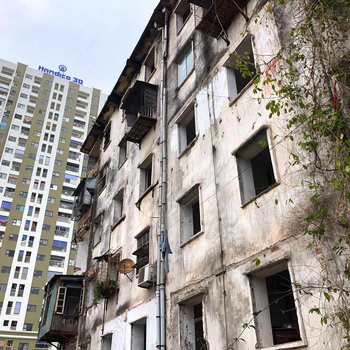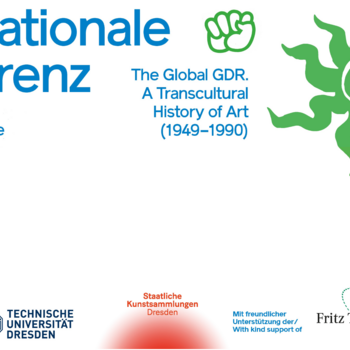Antiimperialistische Solidarität
Der Begriff der antiimperialistischen Solidarität drückte in der politischen Sprache der DDR ihre Beziehungen zu damaligen Nichtblockstaaten und Organisationen aus, insbesondere zu denen, die gegen koloniale Mächte kämpften. Diese Solidarität ging einher mit wirtschaftlicher als auch militärischer Unterstützung, die hauptsächlich dazu diente, den Sozialismus zu fördern. Gleichzeitig verfolgte die DDR dabei auch wirtschaftliche Interessen: In Angola und Vietnam beispielsweise investierte die DDR in Kaffeeplantagen mit der Hoffnung, Kaffee aus diesen Ländern zu erwerben.
Miriam M. Müller: A Spectre is Haunting Arabia. How the Germans Brought Their Communism to Yemen, Bielefeld 2015, S. 124.
DDR Museum Berlin, »Antiimperialistische Solidarität« – Entwicklungshelfer der DDR in Asien (14.1.2016), Link (Stand: 1.9.2023).
Henning von Löwis: Antiimperialistische Solidarität, in: R. Eppelmann, H. Möller, G. Nooke, D. Wilms (Hgg.): Lexikon des DDR-Sozialismus, Bd. 1, Paderborn 1997, S. 74¬–75.
Apartheid
Das Wort Apartheid (aus dem Afrikaans) bedeutet ›Getrenntheit‹ und beschreibt die Politik der Rassentrennung in Südafrika und Namibia, die zur systematischen Privilegierung weißer Menschen und Diskriminierung Schwarzer Menschen und »BIPoC« (Black, Indigenous, People of Color) in allen Lebensbereichen führte. Die DDR-Regierung unterstützte den Kampf gegen Apartheid auf internationaler Ebene und propagierte ihn trotz rassistischen Vorfälle im eigenen Land. Beispielsweise trat die ausgebürgerte Schwarze südafrikanischen Sängerin und Aktivistin Miriam Makeba bei den X. Weltfestspielen der Jugend und Studenten 1973 in Ost-Berlin auf.
Andreas Bohne, Bernd Hüttner, Anja Schade (Hgg.): Apartheid No! Facetten von Solidarität in der DDR und BRD, 2019, Link (Stand: 01.09.2023).
H. Schneider, Apartheid (8.6.2022), Link (Stand: 1.9.2023).
Sebastian Gehrig: Reaching Out to the World. East Germany's Anti-Apartheid and Socialist Human Rights Campaign, in: German History, 36:2018, Heft 4, S. 574–597.
Gaze
Der Begriff Gaze (Englisch) bedeutet ›Anstarren‹ oder ›Blick‹ und kommt ursprünglich aus der Filmtheorie. Er beschreibt, dass unsere Art zu sehen und das Gesehene zu interpretieren immer mit gesellschaftlichen Normen und Machtstrukturen verbunden ist. Der White Gaze (weißer Blick) zeigt beispielsweise meist den Blick weißer Menschen auf die dargestellte Person oder das beschriebene Geschehen: weiße Lebensrealitäten, Normvorstellungen und Erfahrungen stehen dabei im Vordergrund, während die Perspektive von BIPoC* in den Hintergrund gerückt wird oder unsichtbar bleibt.
Informations- und Dokumentationszentrum für Antirassismusarbeit e.V.: Weißer Blick (White Gaze), Link (Stand: 29.9.2023)
Paula Amad: Visual Riposte. Looking Back at the Return of the Gaze as Postcolonial Theory's Gift to Film Studies, in: Cinema Journal 52:2013, Heft 3, S. 49–74.
Corinn Columpar: The Gaze As Theoretical Touchstone. The Intersection of Film Studies, Feminist Theory, and Postcolonial Theory, in: Women's Studies Quarterly 30:2002, Heft 1 u. 2, S. 25–44.
Globale Kunstgeschichte
In den 1980er Jahren entstand der Begriff der globalen Kunstgeschichte und wurde zunächst als ein Phänomen zeitgenössischer Kunst betrachtet. Heute versteht man unter diesem Forschungsbereich eine kritische Auseinandersetzung mit der europäisch zentrierten Kunstgeschichtsschreibung und ihren Methoden. Globale Kunstgeschichte entwickelt eine eigene Sprache und Methoden Kunst als grenzübergreifend, mobil, sich wandelnd und mehrperspektivisch zu erforschen.
Hans Belting: From World Art to Global Art. View on a New Panorama, in: The Global Contemporary and the Rise of New Art Worlds, Ausst.-Kat. ZKM Zentrum für Kunst und Medien, Karlsruhe 2012, hg. v. Hans Belting, Andrea Buddensieg, Peter Weibel, Cambridge 2013, S. 178–185.
Mariachiara Gasparini und Monica Juneja, Interview with Monica Juneja about Global Art History (29.01.2014), Link (Stand: 1.9.2023).
Globaler Süden
Mit den Begriffen Globaler Süden und Globaler Norden wird beschrieben, dass es in einer globalisierten Welt privilegierte und benachteiligte Positionen gibt, die wiederum auf den Kolonialismus zurückgehen und sich bis heute fortsetzen. Nach gesellschaftlichen, ökonomischen und politischen Kriterien bedeutet dies für den Globalen Süden bis heute eine benachteiligte und für den Globalen Norden eine privilegierte Position. Die Bezeichnung ist nur bedingt geografisch zu verstehen und ersetzt eurozentrische und hierarchisierende Einordnungen nach vermeintlichen ›Entwicklungskriterien‹.
glokal e.V. (Hg.): Mit kolonialen Grüßen …. Berichte und Erzählungen von Auslandsaufenthalten rassismuskritisch betrachtet, Berlin 2013, S.8.
Kubanische Revolution
Die Kubanische Revolution war eine soziale und politische Bewegung, die 1959 mit der Unterstützung einer politischen Breite aller Bevölkerungsschichten unter der Führung von Fidel Castro den Diktator Fulgenco Batista auf Kuba stürzte und zur Errichtung des Sozialismus führte. Bis Kuba sich anderen sozialistischen Ländern zuwandte, sollte es noch einige Jahre dauern. Ideologisch unterschied sich Kuba von diesen Staaten, unter anderem in der Kunst: Einflüsse der vorrevolutionären amerikanischen Filmindustrie und Abstraktion, welche sich beispielsweise in Poster im Pop-Art-Stil zeigen, standen in Kuba unter dem Motto »Unser Gegner ist der Kapitalismus, nicht die abstrakte Kunst« und hoben sich deutlich vom Sozialistischen Realismus der DDR ab.
Michael Zeuske, Traditionen, Gegenwart und Zukunft der kubanischen Revolution (4.10.2010), Link (Stand: 1.9.2023).
Tricontinental. Institute for Social Research, The Art of the Revolution Would be Internationalist (8.4.2019), Link (Stand: 1.9.2023).
Kulturelle Aneignung
Der Begriff kulturelle Aneignung beschreibt die unreflektierte Vereinnahmung kultureller Elemente einer strukturell benachteiligten oder minorisierten Gruppe durch eine dominante, privilegierte Gruppe. Dies können zum Beispiel Symbole, Sprache oder künstlerische Praktiken sein.
In der Debatte um den Begriff gibt es unterschiedliche Verständnisse und Bewertungen zwischen den Gruppen, die teilweise unter dem Begriff der ›Kunstfreiheit‹ historische Tatsachen und Gewalt verharmlosen.
Diskriminierungskritische Perspektiven an der Schnittstelle Bildung/Kunst: Kulturelle Aneignung, Link (Stand: 29.9.2023).
Stiftung gegen Rassismus und Antisemitismus: Kulturelle Aneignung (2022), Link (Stand: 1.9.2023).
Migration in der DDR
Migration prägte die DDR seit ihrer Entstehung. Politische Geflüchtete kamen unter anderem aus Spanien, Griechenland und Chile. Auch internationale Studierende kamen seit 1950er Jahren in die DDR. Studierende aus blockfreien und westlichen Staaten brachten Devisen in die DDR. Dagegen kamen Studierende aus sozialistischen Ländern aus ideologischen Gründen. Aus den gleichen Ländern kamen ab den 1980er Jahren Arbeitsmigrant*innen, vorrangig um die DDR-Wirtschaft zu unterstützen. Im Jahr 1989 hatten geschätzt 190.000 Menschen (1,17% der Bevölkerung) in der DDR eine ausländische Staatsangehörigkeit.
Patrice G. Poutrus, Ausländer in Ostdeutschland (24.8.2020), Link (Stand: 18.8.2023).
Andrea Pürckhauer und Paulina Lorenz, Welche Migration gab es in der DDR? (8.11.2019), Link (Stand: 21.8.2023).
Jochen Oltmer, Die DDR – Eine Migrationsgesellschaft? (4.6.2021), Link (Stand: 1.9.2023).
Othering
Othering (Englisch) bedeutet ›Andersmachung‹ oder ›andern‹ und beschreibt die Praktik der Abgrenzung einer Person oder Gruppe zu einer Anderen. Im Zuge dessen wird die nicht-eigene Gruppe als ›fremd‹ definiert und mit negativen Eigenschaftenaußerhalb der akzeptablen Norm abgewertet. In einem Machtgefälle führt diese Zuschreibung zu Benachteiligung im gesellschaftlichen Leben.
Vielfalt Mediathek, Othering, Link (Stand: 1.9.2023).
Zürcher Hochschule der Künste, Othering, Link (Stand: 1.9.2023).
Diversity Arts Culture, Othering, Link (Stand: 1.9.2023).
Anna von Rath, Lucy Gasser, Othering ~ Andern: 10 Schwierig zu übersetzende Begriffe In Bezug auf Identitäten, Link (Stand: 1.9.2023).
Postsozialismus
Der Begriff Postsozialismus stammt meist von westlichen Geisteswissenschaftler*innen, die zwischen 1989–1992 den Zerfall der UdSSR und des Warschauer Paktes untersuchten. Zunächst diente der Begriff dazu, die wirtschaftlichen und politischen Veränderungen nach dem Zusammenbruch sozialistischer Systeme zu erforschen. Der Fokus der Forschung auf Ost- und Mitteleuropa und auf die Aufbruchsstimmung der Ereignisse ist (heute?) umstritten. So wurden unter anderem Perspektiven aus anderen Weltteilen und bestehende Kontinuitäten und Strukturen in den lokalen Orten vernachlässigt.
Alison Stenning: Postsocialism, in: Tim Forsyth (Hrg.), Encyclopedia of International Development. Abingdon 2005, S. 551–553.
Martin Müller: Goodbye, Postsocialism! in: Europe-Asia Studies, 71:2019, Heft 4, S. 533–50.
Putsch in Chile 1973
Am 11.09.1973 putschte das chilenische Militär gegen die gewählte sozialistische Regierung unter Salvador Allende. Die Verfolgung und Ermordung unter dem Putschisten Augusto Pinochet zwang viele Menschen, unter anderem Künstler*innen, Schutz im Ausland zu suchen. Weltweit produzierten chilenische Künstler*innen (im Exil) Werke um an die ermordeten Personen zu erinnern und gegen Pinochet zu protestieren. In der DDR kam der künstlerischen Thematisierung dieses Ereignis eine staatstragende Funktion zu: Öffentliche Denkmäler zur Ehrung von Salvador Allendes wurden in Auftrag gegeben, zumeist jedoch bei Künstler*innen aus der DDR.
John Simalchik: The Material Culture of Chilean Exile. A Transnational Dialogue, in: Refuge: Canada's Journal on Refugees, 25:2016, Heft 23, Nr.2, S. 95–105.
Junge Welt, Buchvorstellung: Chile 1973. Denkmäler und Wandbilder in DDR und BRD (14.7.2023), Link (Stand: 1.9.2023).
Rassismus in der DDR
Die DDR beanspruchte, den Faschismus, Antisemitismus und Rassismus im Rahmen des Klassenkampfes erfolgreich überwunden zu haben. Dieser Grundsatz führte dazu, dass die Realität, in der diese Probleme immer noch präsent waren, oft übersehen wurde. Aktuellere Forschungen zeigen auf, dass die Diskriminierung nicht nur von der Bevölkerung ausgegangen ist, sondern auch staatlich unterstützt wurde. Insbesondere Vertragsarbeiter*innen waren von der Benachteiligung und Ausgrenzung betroffen.
Harry Waibel: Der gescheiterte Antifaschismus der SED-Antisemitismus, Rassismus und Neonazis in der DDR, in: Journal EXIT-Deutschland Zeitschrift für Deradikalisierung und demokratische Kultur: Alter & Neuer Rechtsradikalismus. Bemerkungen zur Historie und Lage in Deutschland, 8:2016, Heft 2, S. 40–67.
Ines Grau: »Aber das ist eigentlich nach der Wende …« von Brüchen und Kontinuitäten rassistischer Erfahrungen mosambikanischer Arbeitsmigrant:innen in der DDR bis in die Gegenwart, in: Institut für Demokratie und Gesselschaft (Hg.): Wissen schafft Demokratie. Tagungsband zur Online-Fachtagung Gesellschaftlicher Zusammenhalt & Rassismus, Band 11., Jena 2022, S. 118–127.
Agneta Jilek: Fremde Freunde. Vietnamesische Vertragsarbeiter in der Fotoserie Ly's Geburtstag (1986–1989) von Matthias Rietschel, in: Dresdner Institut für Kulturstudien e.V. (Hg.): Arbeit! Ostdeutsche Arbeitswelt im Wandel 1945–2015, Dresden 2015, S. 202–207.
Socialist Chromatism
Nach Quinn Slobodian beschreibt der Socialist Chromatism / sozialistische Chromatismus ein Darstellungsmotiv auch in der bildenden Kunst in der DDR, in dem mehreren Menschen unterschiedlicher Hautfarbe mit stereotypisierenden körperlichen und kulturellen Merkmalen zu sehen sind. Die unreflektierte Verwendung rassistisch beladener ethnografischer Vorlagen und die Platzierung einer weißen Figur als führendes Bildelement sah Slobodian als Widerspruch zu der angeblich antirassistischen und antiimperialistischen Haltung der DDR.
Quinn Slobodian (Hg.): Comrades of Color. East Germany in the Cold War World, New York/Oxford 2015, S. 23–42.
Sozialistischer Imperialismus
Die UdSSR als Imperium begann unter Stalin, als er die russische Kultur innerhalb des Vielvölkerstaats wieder propagierte – gegenüber Lenins Entscheidung, die Nationalgefühle der Nationen (Ukraine, Weißrussen, usw.) zu verstärken. Nach dem zweiten Weltkrieg fungierten militärische Einmärsche in Staaten des Warschauer Paktes und Verbreitung des Sozialismus nach sowjetischem Vorbild als weltweite Aufrechterhaltung und Verbreitung der Hegemonie der UdSSR. Dieser Gedanke wurde zuerst u. a. von der Volksrepublik China in den 70er Jahren verwendet.
Albert Szymanski: Soviet Social Imperialism, Myth or Reality. An Empirical Examination of the Chinese Thesis, in: Berkeley Journal of Sociology 22:1977, Heft 22, S. 131–166.
Manfred Wilke, Steffen Alisch: Internationalismus, proletarischer und sozialistischer, in: R. Eppelmann, H. Möller, G. Nooke, D. Wilms (Hgg.): Lexikon des DDR-Sozialismus, Bd. 1, Paderborn 1997, S. 414–416.
Terry Martin: An Affirmative Action Empire. The Soviet Union as the Highest Form of Imperialism, in: Ronald Grigor, Terry Martin (Hg.): A State of Nations. Empire and Nation-Making in the Age of Lenin and Stalin, New York 2001, S. 67–90.
Gerd Schneider und Christiane Toyka-Seid, Sowjetunion (UDSSR), Link (Stand: 1.9.2023).
Völkerfreundschaft
Der Begriff der Völkerfreundschaft (дружба народов/druzhba narodov)1 stammt aus der UdSSR der 1930er Jahre, um die unterschiedlichen ethnografischen Bevölkerungsgruppen zu vereinen. Grundlegend für diesen Begriff ist die Idee, dass sich die Werktätigen aller Länder im Klassenkampf gegen den nationalistisch denkenden Bourgeoisie befänden und dadurch freundschaftlich nebeneinander stehen. Außenpolitisch wurde der Begriff ab 1970 verwendet, um ein positives Bild der DDR nach außen, vor allem an neue unabhängige Staaten, heranzutragen.
Birgit Wolf: Sprache in der DDR. Ein Wörterbuch (S. 238–239).
Terry Martin: An Affirmative Action Empire. The Soviet Union as the Highest Form of Imperialism, in: Ronald Grigor, Terry Martin (Hg.): A State of Nations. Empire and Nation-Making in the Age of Lenin and Stalin, New York 2001, S. 67–90.
(1) The Great Soviet Encyclopedia, Friendship of Peoples, Link (Stand: 1.9.2023).
Vietnamkrieg
Der Vietnamkrieg dauerte von 1955–1975 und hat bis heute Auswirkungen auf Vietnam und Deutschland. In der DDR begann schon im Jahr 1955, u. a. verstärkt durch das Programm Solidarität hilft Siegen, die Aufnahme von Schüler*innen und Wissenschaftler*innen aus Vietnam in Bildungseinrichtungen. Die wirtschaftliche Zusammenarbeit führte zu den Wohnbauten in der Stadt Vinh, die bis heute bewohnt werden. Viele ehemalige vietnamesische Vertragsarbeiter*innen leben mit ihren Familien bis heute in Deutschland.
Ronald H. Spector, Vietnam War. 1954–1975 (31.8.2023), Link (Stand: 1.9.2023).
Karin Weiss, Vietnam. Netzwerke zwischen Sozialismus und Kapitalismus (30.6.2005), Link (Stand: 23.8.2023).
Christina Schwenkel: Den globalen Sozialismus aufbauen. Zur Geschichte der DDR-Stadtplanung in Vinh, In: ARCH+ 49:2016, Heft 226/227, S. 30–41.

Auch interessant:
Qingmei YAOs Film „The Trial“ wird gegenwärtig im Rahmen des „Kontrapunkte“-Projekts in unserer Serie über China gezeigt. Der Film ist als absurdes Theater konzipiert, in dem die Regisseurin selbst als militante Figur in Uniform auftritt und einen Cola-Automaten verhört. In diesem Interview spricht sie über die Entstehung der Idee und die ambivalente Position Chinas zwischen Sozialismus und Turbokapitalismus.

Die Vernichtung von Vinh City durch die US-Bombenangriffe bot die Gelegenheit zur experimentellen Planung und Umwandlung der kleinen Industriestadt in eine sozialistische Modellstadt. Die ehrgeizige Aufgabe der DDR, der allumfassende Wiederaufbau, bestand in der gemeinsamen Arbeit an der Erstellung eines Masterplans und dessen Umsetzung in die Realität. Christina Schwenkel über den Quang Trung Wohnkomplex.

Mit dem Projekt „Kontrapunkte“ unternehmen die SKD einen Blick auf die internationale Geschichte des DDR-Kulturbetriebs. Dabei geht es um die eigene Sammlungsgeschichte, um Austausch und Vernetzung, vor allem aber um eine Korrektur des Narrativs, das diese Geschichte als die eines provinziellen Betriebs erzählt, der isoliert und jenseits der Moderne stattfindet. Die Professur für Bildwissenschaft im globalen Kontext von der TU Dresden hat im Juni mit dem Albertinum und der Kustodie der TU eine Tagung zu den Beziehungen des DDR-Kulturbetriebs in den globalen Süden veranstaltet.
